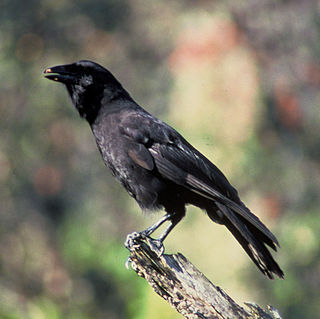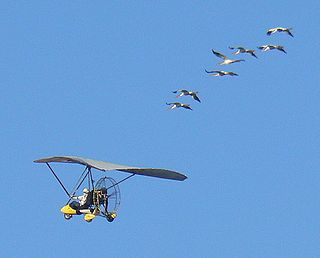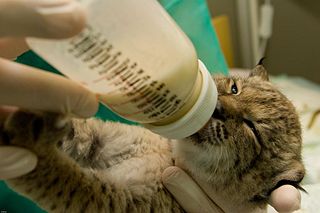
The falcons and caracaras are around 65 species of diurnal birds of prey that make up the family Falconidae. The family likely originated in South America during the Paleocene and is divided into three subfamilies: Herpetotherinae, which includes the laughing falcon and forest falcons; Polyborinae, which includes the spot-winged falconet and the caracaras; and Falconinae, the falcons and kestrels (Falco) and falconets (Microhierax).

The peregrine falcon, also known simply as the peregrine, is a cosmopolitan bird of prey (raptor) in the family Falconidae. A large, crow-sized falcon, it has a blue-grey back, barred white underparts, and a black head. The peregrine is renowned for its speed. It can reach over 320 km/h (200 mph) during its characteristic hunting stoop, making it the fastest animal on the planet. According to a National Geographic TV program, the highest measured speed of a peregrine falcon is 389 km/h (242 mph). However, radar tracks have never confirmed this, the maximum speed reliably measured is 184 km/h (114 mph), but nobody has been able to present unimpeachable measurements of speeds even close to the "well-known" 300 km/h (190 mph). As is typical for bird-eating (avivore) raptors, peregrine falcons are sexually dimorphic, with females being considerably larger than males. Historically, it has also been known as "black-cheeked falcon" in Australia, and "duck hawk" in North America.

Falconry is the hunting of wild animals in their natural state and habitat by means of a trained bird of prey. Small animals are hunted; squirrels and rabbits often fall prey to these birds. Two traditional terms are used to describe a person involved in falconry: a "falconer" flies a falcon; an "austringer" keeps Goshawks and uses accipiters for hunting. In modern falconry, the red-tailed hawk, Harris's hawk, and the peregrine falcon are some of the more commonly used birds of prey. The practice of hunting with a conditioned falconry bird is also called "hawking" or "gamehawking", although the words hawking and hawker have become used so much to refer to petty traveling traders, that the terms "falconer" and "falconry" now apply to most use of trained birds of prey to catch game. However, many contemporary practitioners still use these words in their original meaning.
In psychology and ethology, imprinting is any kind of phase-sensitive learning that is rapid and apparently independent of the consequences of behaviour. It was first used to describe situations in which an animal or person learns the characteristics of some stimulus, which is therefore said to be "imprinted" onto the subject. Imprinting is hypothesized to have a critical period.

The red kite is a medium-large bird of prey in the family Accipitridae, which also includes many other diurnal raptors such as eagles, buzzards, and harriers. The species currently breeds only in Europe, though it formerly also bred in west Asia and northwest Africa. Historically, it was only resident in the milder parts of its range in western Europe and northwestern Africa, whereas all or most red kites in northern mainland Europe wintered to the south and west, some also reaching western Asia, but an increasing number of northern birds now remain in that region year-round. Vagrants have reached north to Finland and south to Israel, Libya and Gambia.

The Hawaiian crow or ʻalalā is a species of bird in the crow family, Corvidae, that is currently extinct in the wild, though reintroduction programs are underway. It is about the size of the carrion crow at 48–50 cm (19–20 in) in length, but with more rounded wings and a much thicker bill. It has soft, brownish-black plumage and long, bristly throat feathers; the feet, legs, and bill are black. Today, the Hawaiian crow is considered the most endangered of the family Corvidae. They are recorded to have lived up to 18 years in the wild, and 28 years in captivity. Some Native Hawaiians consider the Hawaiian crow an ʻaumakua.

The northern bald ibis, hermit ibis, or Waldrapp is a migratory Old World ibis found in open areas such as grasslands, rocky mountains, and semi-deserts, often close to running water. This 70–80 cm (28–31 in) glossy black ibis, which, unlike many members of the ibis family, is non-wading, has an unfeathered red face and head, and a long, curved red bill. It breeds colonially on coastal or mountain cliff ledges, where it typically lays two to three eggs in a stick nest, and feeds on lizards, insects, and other small animals.

The whooping crane is an endangered crane species, native to North America, named for its "whooping" calls. Along with the sandhill crane, it is one of only two crane species native to North America, and it is also the tallest North American bird species. The whooping crane's lifespan is estimated to be 22–24 years in the wild. After being pushed to the brink of extinction, due to unregulated hunting and loss of habitat, and just 21 wild cranes remaining by 1941, conservation efforts would lead to a partial recovery. The total number of cranes in the surviving migratory population, plus three reintroduced flocks and in-captivity, only slightly exceeds 800 birds as of 2020.

Egg incubation is the process by which an egg, of oviparous (egg-laying) animals, develops an embryo within the egg, after the egg's formation and ovipositional release. Egg incubation is done under favorable environmental conditions, possibly by brooding and hatching the egg.

The scarlet macaw' also called the red-and-yellow macaw, red-and-blue macaw or red-breasted macaw, is a large yellow, red and blue Neotropical parrot native to humid evergreen forests of the Americas. Its range extends from southeastern Mexico to Peru, Ecuador, Colombia, Bolivia, Venezuela, Honduras, and Brazil in lowlands of 500 m (1,600 ft) up to 1,000 m (3,300 ft), the Caribbean island of Trinidad, as well as the Pacific island of Coiba. Formerly, the northern extent of its range included southern Tamaulipas. In some areas, it has suffered local extinction because of habitat destruction, or capture for the parrot trade, but in other areas, it remains fairly common. It is the national bird of Honduras. Like its relative the blue-and-yellow macaw, the scarlet macaw is a popular bird in aviculture as a result of its striking plumage. It is the third most common macaw species in captivity after the Blue and Gold and Greenwing Macaw respectively. In recent years it has become much rarer in captivity and much more expensive due to its placement on CITES Appendix I.
The World Center for Birds of Prey in Boise, Idaho, is the headquarters for The Peregrine Fund, an international non-profit organization founded in 1970 that conserves endangered raptors around the world.

The king quail, also known as the blue-breasted quail, Asian blue quail, Chinese painted quail, or Chung-Chi, is a species of Old World quail in the family Phasianidae. This species is the smallest "true quail", ranging in the wild from southern China, South and Southeast Asia to Oceania, south to southeastern Australia, with 9 different subspecies. A failed attempt was made to introduce this species to New Zealand by the Otago Acclimatisation Society in the late 1890s. It is quite common in aviculture worldwide, where it is sometimes misleadingly known as the "button quail", which is the name of an only very distantly related family of birds, the buttonquails.
Cross-fostering is a technique used in animal husbandry, animal science, genetic and nature versus nurture studies, and conservation, whereby offspring are removed from their biological parents at birth and raised by surrogates, typically of a different species, hence 'cross.' This can also occasionally occur in nature.

The crested ibis, also known as the Japanese crested ibis, Asian crested ibis or toki, is a large, white-plumaged ibis of pine forests, native to eastern Asia. Its head is partially bare, showing red skin, and it has a dense crest of white plumes on the nape. It is the only member of the genus Nipponia.
Hacking is a training method that helps young birds of prey reach their hunting potential by giving them exercise and experience. This technique is used to prepare the falcon to become an independent hunter. The sequence of the procedure includes captivity, releasing, flight, and either the falcon will be recaptured for falconry or released into the wild. This has also been adapted to other raptor species to preserve the population. Generally, falconers agree that hacked falcons are better and more preferred in the field. Hacking is beneficial, not only for the falconers, but for the bird itself and the species; however, there are some criticism and restrictions that come along with this method.

An incubator is a device simulating avian incubation by keeping eggs warm at a particular temperature range and in the correct humidity with a turning mechanism to hatch them.

Operation Migration was a nonprofit, charitable organization, which developed a method using ultralight aircraft to teach migration to captive-raised, precocial bird species such as Canada geese, trumpeter swans, sandhill cranes, and endangered whooping cranes.
Fostering, in falconry and reintroduction of birds, is a method of breeding birds for their introduction into the wild that consists of placing chicks in the nest of a couple that has others of a similar age and size. Sometimes it can also be used when the chicks have already left the nest but continue to be fed by their parents.

Human-guided migration or human-led migration is a method of restoring migratory routes of birds bred by humans for their reintroduction into the wild.

Hand-rearing, artificial-rearing, human-rearing or hand-raising is the process of caring for and feeding juvenile animals by humans during a stage when they would normally be fed by their parents.















